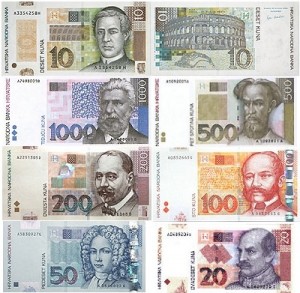Croatian Kuna
Short facts about HRK – Croatian Kuna
![]()
Read our in-depth guide about the Croatian Kuna (HRK) below:
- Common names for Croatian Kuna
- Countries with Croatian Kuna
- How much is the Croatian Kuna traded?
- Currency symbol and ISO-code
- Currency crisis with Croatian Kuna
- The Croatian National Bank
- Online Forex Trading with Croatian Kuna
- History of the Croatian Kuna
- HRK vs other currencies
- Pictures of Croatian Kuna
Common names for HRK
The kuna (HRK) is the currency of Croatia. It is divided into 100 lipa. It should not be confused with the koruna (crown), an erstwhile unit of currency in some Slavic countries. Etymologically kuna (marten) derives its meaning from a different root, the marten pelts which were used as units and tokens of currency in the Middle Ages.
Countries with HRK
The Republic of Croatia is the only country with the Croatian Kuna as currency.
Unofficial HRK countries
No other country uses the Croatian kuna (HRK).
How much are the HRK traded?
The Croatian kuna (HRK) is relatively minor in terms of frequently traded currencies. Most traders would consider the euro to be a more popular choice, and the kuna is takes the euro as its main reference currency.
Currency symbol and ISO-code
The Croatian currency is designated thus: kn for kuna and lp for lipa, both written after the numerals. The ISO-code for the kuna is HRK.
Currency crisis with HRK
By the end of the 1990s following the War of Independence, the Croatian economy faced a period of depression. Further economic problems were created by the Croatian privatization controversy, a series of badly handed attempts at privatisation. The value of the kuna fell, and a tighter fiscal policy was introduced to re-establish stability.
A new government in 2000 brought a series of economic and structural reforms. Economic decline was halted and a slow growth came to the Croatian economy. Croatian foreign debt remained high, since the kuna’s exchange rate to the US dollar is affected by the EUR/USD rate.
Since the Croatian economy is significantly dependent on trade with other nations in Europe, it is affected by European trends, including the financial crisis in 2008.
Central Bank for HRK
The Croatian National Bank (HNB from the Croatian Hrvatska narodna banka) is Croatia’s central bank. It has responsibility for the stability of HRK and safeguarding the finances of the nation. It was established in 1990 as an independent institution answerable to the Croatian parliament.
Trade HRK
The value of the Croatian kuna (HRK) is generally related to the value the euro. The policy of the Croatian central bank has kept the rate relatively stable against the euro, without wild fluctuations in the variable rate.
History of the HRK
After the Second World War Croatia was a semi-autonomous federal region in the former Yugoslavia. As the Yugoslav Federation fragmented Croatia declared independence in 1991, but had to fight for its freedom in the early 1990s during the Croatian War of Independence.
During this time the Yugoslav dinar was replaced by the Croatian dinar (HRD) at par.
The kuna (HRK) was introduced in 1994, controversially taking the same name as the currency issued by the Ustaše-controlled Independent State of Croatia during World War Two. However the use of the word kuna for a unit of currency had a longer pedigree in Slavic languages, going back to the use of marten pelts as a method of trade in the Middle Ages and beyond.
The currency’s main reference point in the international market was initially the German mark. With Germany’s adoption of the euro, Croatia began to use the European currency as its main reference for the kuna.
Croatia is due to formally join the EU at the beginning of 2013, and expected to subsequently adopt the euro within a few years.
HRK vs other currencies
The Croatian kuna (HRK) is traded freely under floating exchange rate.
Pictures of HRK notes and coins
Below are images of the Croatian currency, both notes and coins:







